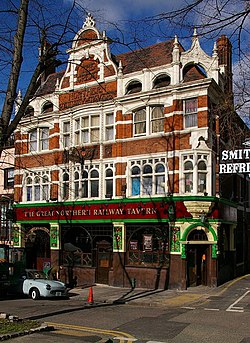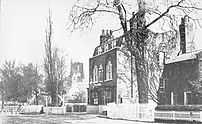Hornsey
| Hornsey | |
| Middlesex | |
|---|---|
 The Great Northern Railway Tavern, Hornsey High Street | |
| Location | |
| Grid reference: | TQ305895 |
| Location: | 51°35’14"N, 0°7’19"W |
| Data | |
| Post town: | London |
| Postcode: | N8 |
| Dialling code: | 020 |
| Local Government | |
| Council: | Haringey |
| Parliamentary constituency: |
Hornsey and Wood Green |
Hornsey is a town in northern Middlesex, within the metropolitan conurbation.
So contiguous is the townscape that the boundaries of Hornsey today cannot be defined, but it is centred around Hornsey High Street, at the eastern end of which is the churchyard and tower of the former parish church which used to be the administrative centre of Hornsey parish.
North of Hornsey High Street, and immediately to its south, some of the area is council housing, surrounded by the late Victorian terraces developed by builders such as John Farrer. Between the western end of the High Street and the bottom of Muswell Hill, the character of the area changes dramatically. Much of this part is the Warner Estate built up with large well-appointed late Victorian houses. To the south west of the High Street is Priory Park, a pleasant urban green space.
Around the town
The High Street has a range of shops and an increasing number of restaurants. The eastern section retains strong echoes of its rural past and hosts the 13th Century tower which is all that remains of St Mary's Church.
On the north side of the High street is the old public bath and wash house. Opened in 1932, it had 33,000 users a year in the 1950s.[1] It is now abandoned and sits on a site the future of which is documented here. A small group of local residents have suggested that it be developed as an arts and crafts studio and gallery for local artists.
Hornsey is also the place where the BBC period drama The Hour was filmed. Hornsey's Town Hall was used within the show.[2]
History
The name Hornsey suggests that it is derived from the name of an otherwise unknown Saxon chieftain named Hæring or Hær, to give us "Haering's enclosure" or Hær's kin's enclosure". It shares this derivation with Harringay neighbourhood. The 'Haringey' variant is the oldest recorded form.

Hornsey Village, which was first recorded in 1202 according to the Place Names of Middlesex, was the focus of parish with its Church first mentioned in 1291. The village developed along what is now Hornsey High Street, and in the seventeenth century it was bisected by the New River that crossed the village in three places: first at the end of Nightingale Lane, secondly from behind the Three Compasses and lastly, as it does now, at the bottom of Tottenham Lane. The village grew dramatically after about 1860 and eventually merged with the separate settlement at Crouch End (first mentioned in 1465) to form an urban area in the middle of the parish.
Much of Hornsey was built up in Edwardian times, but the tower of the original parish church still stands in its ancient graveyard in Hornsey High Street, at the centre of the old village. Other notable places are the Doragh Gasworks, the former Hornsey Town Hall in Crouch End, and Highpoint and Cromwell House in Highgate.
In 1954 the first Lotus Cars factory was established behind the Railway Hotel (now Funky Brownz Bar) on Tottenham Lane.
Nearest stations
Tube station
- Turnpike Lane
Railway stations
- Crouch Hill
- Hornsey
- Harringay
References
- ↑ Hornsey Past by Steven Denford (Historical Publications 2008
- ↑ "Hornsey Town Hall’s Hour in the spotlight". haringey.gov.uk. http://www.haringey.gov.uk/hornsey-town-hall-hour-in-the-spotlight.htm. Retrieved 13 November 2012.
Outside links
- Harringay Online N8's biggest community website - for Harringay, Hornsey & Crouch End
- Local community website for all of N8, i.e. Crouch End and Hornsey
- Hornsey Historical Society
- The Colin Chapman Museum and Education Centre - includes a history of Lotus in Hornsey